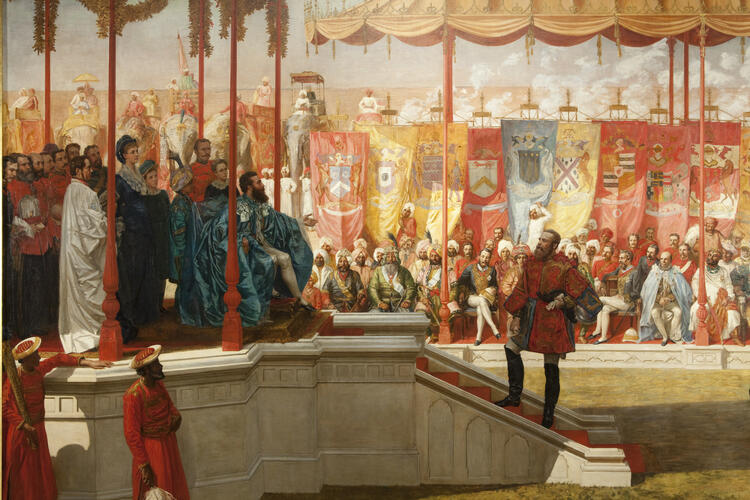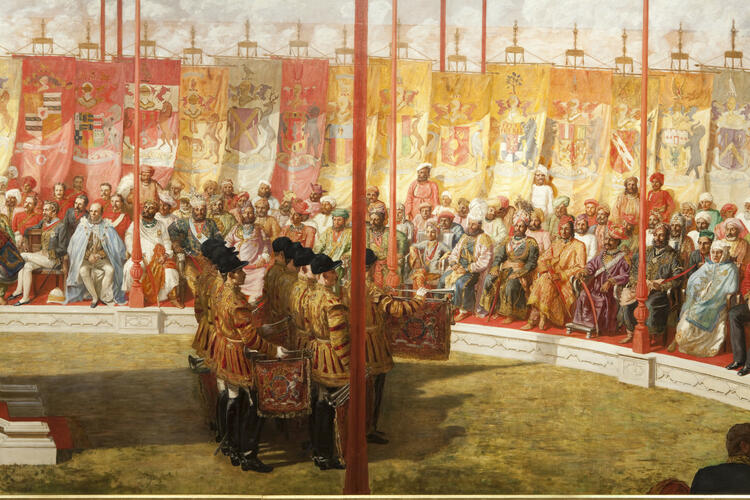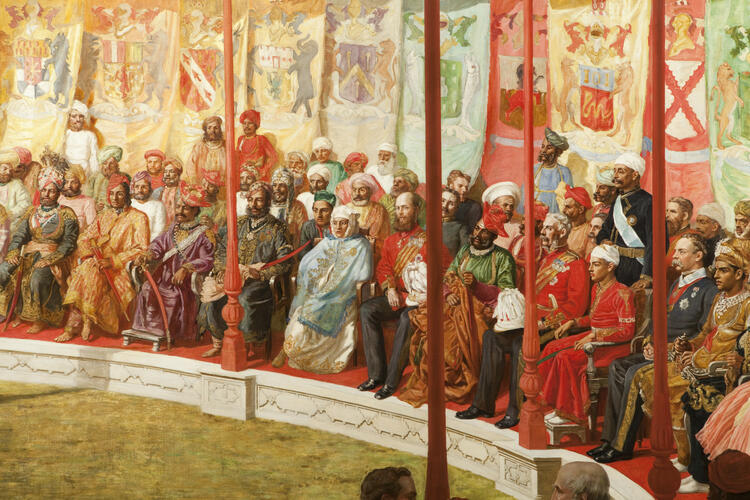-
1 of 253523 objects
The Imperial Assemblage held at Delhi, 1 January 1877 Signed and dated 1877-80
Oil on canvas | 304.8 x 723 cm (support, canvas/panel/stretcher external) | RCIN 407181

Valentine Cameron Prinsep (1838-1904)
The Imperial Assemblage held at Delhi, 1 January 1877 Signed and dated 1877-80

Valentine Cameron Prinsep (1838-1904)
The Imperial Assemblage held at Delhi, 1 January 1877 Signed and dated 1877-80

Valentine Cameron Prinsep (1838-1904)
The Imperial Assemblage held at Delhi, 1 January 1877 Signed and dated 1877-80

Valentine Cameron Prinsep (1838-1904)
The Imperial Assemblage held at Delhi, 1 January 1877 Signed and dated 1877-80




-
Lord Lytton was appointed Viceroy and Governor-General of India by the Prime Minister, Benjamin Disraeli, late in 1875. Queen Victoria assumed the title of Empress of India on 1 May 1876. Lord Lytton organised the Imperial Assemblage as a means of 'publicly announcing Your Majesty's present title to the Chiefs and princes of India with the utmost pomp and magnificence'. On a site four miles to the north-west of Delhi a red and gold hexagonal Throne Pavilion was constructed for the Viceroy. Facing it, for the Princes, representatives of foreign governments and chief British officials was a semi-circular Amphitheatre in blue, white and gold, 800 feet long. The 63 Princes 'all in gorgeous costumes of satin, velvet, or cloth of gold' attended. Just before the ceremony they were each presented with a silken banner bearing their own arms and the date of the event (hanging above them in the painting). About 100,000 people were camped in the area for the occasion, in addition to hundreds of horses, elephants (lined up in the background on the left) and camels. Lord Lytton, seated on the dais, wore the mantle of Grand Master of the Star of India. Lady Lytton and her two daughters stood behind him. She wore 'a lovely gown of purple blue silk and velvet stamped with blue velvet brocade'. After a fanfare of trumpets Major Barnes 'an enormous man of, I am sure, seven feet' according to Lady Lytton, read the proclamation – he can be seen standing on the steps.
Lord Lytton wrote to Queen Victoria explaining that the Princes wanted a 'pictorial record of the event to be painted by a good English artist for presentation to Your Majesty'. Prinsep was from an Anglo-Indian family and had been born in Calcutta. He was very aware of the difficulty posed by the task and noted that 'Of necessity my picture must be a picture commemorative of the Assemblage rather than a faithful reproduction of the scene'. He managed to get photographs of some of the participants and spent months after the event travelling around India obtaining sittings from the Princes for their portraits. There are nearly 160 recognisable portraits in the finished painting. The final painting is huge, but it is still a shrunken representation of the Assemblage. The centre of the arc of the Amphitheatre was in fact 226 feet from the Viceroy's Pavilion – in the painting it is nearer 30 feet. Each of the Pavilion's hexagonal sides was 40 feet long in reality, but in the picture they are nearer six feet, and the decoration of the Pavilion was far more elaborate than appears in Prinsep's picture. Back in London, the painting entirely filled the artist's especially enlarged studio. It took 14 skilled men to move it 'in a folded shape' to the Royal Academy in 1880, and Prinsep had to finish it there, after the exhibition had closed.
Signed and dated: VAL.C.PRINSEP / 1877-80.Provenance
Presented by the people of India to Queen Victoria
-
Creator(s)
Acquirer(s)
Subject(s)
-
Medium and techniques
Oil on canvas
Measurements
304.8 x 723 cm (support, canvas/panel/stretcher external)
415 x 901.5 x 21.6 (frame, external)
304.8 x 823.0 cm (support, canvas/panel/stretcher external)
Other number(s)
Alternative title(s)
Queen Victoria proclaimed Empress of India, 1 January 1877
The Durbar at Delhi, January 1 1877, previously entitled